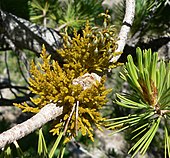Sandalwood
| Sandalwood | ||||||||||||
|---|---|---|---|---|---|---|---|---|---|---|---|---|

Sandalwood tree ( Santalum album ), illustration |
||||||||||||
| Systematics | ||||||||||||
|
||||||||||||
| Scientific name | ||||||||||||
| Santalaceae | ||||||||||||
| R.Br. |
The sandalwood family (Santalaceae) are a family of flowering plants (Magnoliopsida). The 38 to 44 genera with about 990 species are distributed almost worldwide, outside of cold areas, especially in the tropics . Some species of the genus sandalwood trees ( Santalum ) provide sandalwood and sandalwood oil . The semi-parasitic mistletoe ( Viscum ) are also known .
description
Appearance and leaves
They are mostly woody plants: mostly shrubs , rarely trees ; or they are parasitic herbaceous plants . In some species take over instead of the leaves stems the photosynthesis . The leaves are well developed or greatly reduced. The leaves are mostly alternate. The stomata are mostly paracytic. There are no stipules.
Inflorescences, flowers and fruits
They are mostly dioecious ( dioecious ), rarely single ( monoecious ) separate sexes. The very small, radial symmetry flowers are hermaphroditic or unisexual and are three to six-fold (rarely eight-fold). There are usually three, rarely two, four or five carpels present. The ovary is subordinate. There are berries , seeded drupes or nuts formed.
Surname
The Greek word sántalon ('sandalwood', 'Indian color wood') on which sandalwood is based is derived from Arabic / Persian chandal and related to old Indian candana , which was primarily used to describe the color wood of the Indian red sandalwood tree (Pterocarpus santalinus), derived from candráh (,bright').
Systematics and distribution
The family occurs worldwide outside of cold areas. It is particularly rich in species in the tropics .
The family Santalaceae s. l. contains in the scope of APG III all taxa of the former families of the Anthobolaceae, Arceuthobiaceae, Canopodaceae, Eremolepidaceae, Lepidocerataceae, Exocarpaceae, Bifariaceae, Ginalloaceae, Osyridaceae, Phoradendraceae, Mistcelaceae. According to Daniel L. Nickrent et al. in Taxon , Volume 59, 2010, pp. 538–558, however, there is a new classification of the Santalales; here, among other things, the Thesiaceae and the Viscaceae are again regarded as separate families. According to Nickrent et al. 2010 belong to the family Santalaceae s. st. in the narrower sense only the genera Antidaphne , Colpoon , Elaphanthera , Eubrachion , Exocarpos , Lepidoceras , Myoschilos , Nestronia , Omphacomeria , Osyris , Rhoiacarpos and Santalum .
| The family Santalaceae contains about 38 to 44 genera with about (400 to) 990 species: |
|---|

Honey Fragrant rod bush ( Osyris alba ), fruiting

Alpine flax leaf ( Thesium alpinum )
|
swell
- The family of Santalaceae in APWebsite. (Sections systematics and description)
- The Santalaceae family at DELTA by L. Watson and MJDallwitz. (Section description)
- The Santalaceae family in Parasitic Plants.
- Daniel L. Nickrent, Lytton J. Musselman: Introduction to Parasitic Flowering Plants . In: The Plant Health Instructor , 2004: online doi: 10.1094 / PHI-I-2004-0330-01 .
- Daniel L. Nickrent, Valéry Malécot, Romina Vidal-Russell, Joshua P. Der: A revised classification of Santalales. In: Taxon , Volume 59, 2010, pp. 538-558. PDF.
Individual evidence
- ^ Franz Dornseiff : The Greek words in German. Berlin 1950, p. 48.
- ↑ Helmut Genaust: Etymological dictionary of botanical plant names. Birkhäuser, Basel / Stuttgart 1976, ISBN 3-7643-0755-2 , p. 328.
- ↑ Kluge: Etymological dictionary of the German language .
- ^ A b Santalaceae in the Germplasm Resources Information Network (GRIN), USDA , ARS , National Genetic Resources Program. National Germplasm Resources Laboratory, Beltsville, Maryland. Retrieved December 2, 2013.
- ^ David John Mabberley: Mabberley's Plant-Book. A portable dictionary of plants, their classification and uses. 3. Edition. Cambridge University Press, 2008, ISBN 978-0-521-82071-4 ( limited preview in Google Book Search).





